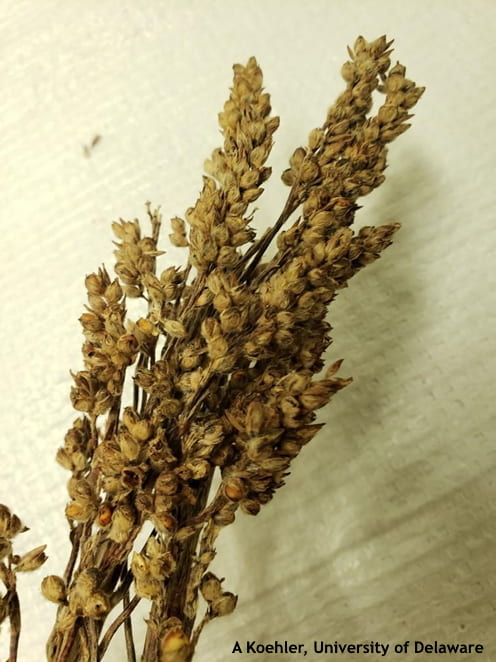Alyssa Koehler, Extension Field Crops Pathologist; akoehler@udel.edu
A broad range of diseases can affect sorghum. Over the course of the season, root rots, foliar pathogens, stalk rots, and head molds can all impact yield potential. One of the most common diseases in our area is Sorghum Anthracnose caused by Colletotrichum species. Symptoms include red to tan lesions on the leaves or stems, stalk rot, or grain infection. Fungal structures resembling pincushions (acervuli with setae) can be observed within the lesion with the aid of a hand lens or other magnification (Figure 1). In susceptible lines, yield loss of up to 50% has been reported. Last year was very conducive for disease and I saw quite a few fields with high levels of disease. In addition to foliar symptoms, I was also seeing disease on panicles and grain, with serious yield loss observed in these cases (Figure 2). The rain of the past week two weeks and high humidity are setting up the right environmental conditions for disease to be observed again this year. Resistant hybrids, seed treatments, and fungicides can be used to try to manage this disease. Work out of Virginia Tech has shown that fungicides (priaxor or headline) were most effective at protecting yield in diseased fields when applied at flowering. Each percent increase of anthracnose disease severity can account for 0.5-1.25 bu/ac of lost yield potential (https://apsjournals.apsnet.org/doi/abs/10.1094/PDIS-10-18-1867-RE). Scouting is important to determine the level of disease prior to flowering. Some studies have shown that the timing of disease onset is just as or more important than final severity, especially in wet, humid years. As a field approaches flowering, if disease is absent or low, a fungicide application is often not profitable for sorghum.
After grain fill, head molds become another concern. Head molds can cause pre- and post-harvest damage, reduce yield, and some of the fungi infecting the grain may form mycotoxins that can lead to quality issues. Chemical control of head mold fungi is typically not effective, insect control may be a better target since head molds are often associated with insect damage. Keeping mature grain from getting wet also helps to reduce head mold issues, but this can be a challenge depending on environmental conditions near the time of harvest. Hybrids are available that vary in susceptibility to anthracnose and head molds. Selecting moderately resistant lines over susceptible or very susceptible lines can help to reduce yield loss and mycotoxin contamination.

Figure 1. Sorghum Anthracnose lesion magnified to view fungal structures

Figure 2. Sorghum head with very little grain following the grain phase of Sorghum Anthracnose
